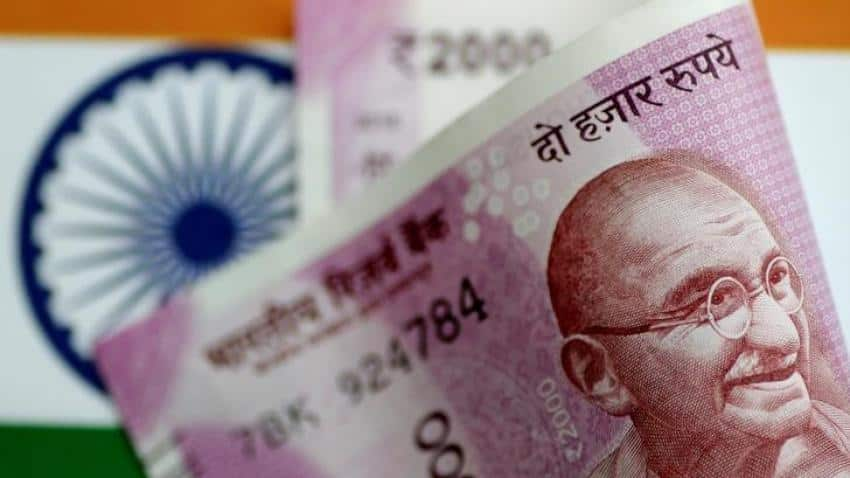Rupee plunges 6% in May, can 7.7% GDP growth soothe Indian currency ahead of RBI policy?
The rupee has continued to depreciate against the US dollar in May, and it has now weakened by over 6% so far this year.

India’s Gross Domestic Product (GDP) numbers surpassed analysts estimates during fourth quarter ended of FY18 (Q4FY18) with a growth rate of 7.7% which is a 18-month high. With this robust performance, India has stayed the fastest growing economy globally. Such an outcome comes as a feather in Narendra Modi government’s cap after having been blamed for hampering the economy due to the demonetisation drive and early launch of Goods and Services Tax (GST). When the number came in on Friday, the Indian rupee strengthened against the US benchmark dollar index on the same day. The rupee has continued to depreciate against the US dollar in May, and it has now weakened by over 6% so far this year. This places the rupee among the worst performing major Asian currencies in 2018.
However, on Friday, the Indian rupee finished at 66.935 mark above 0.505 points or 0.75% against dollar. This would mean that rupee is at one month high, as the last time it witnessed near 66-mark was on May 03, 2018. In the month of May, the domestic unit has been hovering at 16-month low between 67-68 level against dollar.
The GDP numbers can come as a booster for Indian rupee who have witnessed heavy pressure from rising crude oil prices. The depreciating rupee has also been an outcome of continuous foreign outflows from Indian markets.
From January to May 2018, foreign portfolio investors (FPI) have removed their money to to the tune of Rs 32,077 crore cumulatively in equity, debt and hybrid market. These investors pumped of Rs 1,18,251 crore last year same period, as per data given on NSDL.
It was only in January 2018, when FPIs made heavy inflow of Rs 22,272 crore in Indian market, which later dropped to Rs 11,674 crore in February month. However, the inflows did bounced back to Rs 2,662 crore in March month, but this soon turned to continuous outflows of Rs 15,561 crore and Rs 29,776 crore in April and May month respectively.
Meanwhile, international crude prices have been trading between $80 per barrel to $75 per barrel in the month of May.
Risk appetite in EM equities and bonds and oil prices have bearing on Rupee. Though oil remains high but risk appetite is supportive of Rupee.
Anindya Banerjee, analysts at Kotak Institutional Equities said, “ Rupee has reacted positively to the GDP growth data, which appreciated to 67.22 levels on spot, down from 67.45 levels of yesterday. The upward bias in Indian bond yields have not had much impact on Rupee.”
According to Banerjee, Indian economic growth will continue to improve as formalisation in the economy and simplification of tax structure will enable an even better growth environment growth going forward. Global economic tailwind remains an added advantage. However, headwind of twin-balance sheet stress (corporates & banks) and higher oil prices will have some dampening effect on growth.
Banerjee adds, “Bonds are expected to be under pressure, as oil prices have bounced and US yields have found support around 2.80% on the year. At the same time, a strong GDP growth report will bolster the chances of a RBI hike soon. RBI is expected to move on rates, if it has to keep to its commitment on real rates.”
She explained that, as inflation is expected to pick up towards 5.25-5.50% by end of FY19, unless RBI hikes the repo rates, real rates can decline towards 50-75 bps, 75-125 bps lower than RBI's guided corridor of 150-200 bps. Therefore, Kotak hope RBI remains committed to the real rate corridor, otherwise it can have adverse impact on the value of the Rupee.
“As political uncertainty can override the attractiveness of high real rates. Without a strong economy, it becomes difficult to sustain high positive real rates. We are in a pre-election year, political uncertainty is expected to remain elevated. Growth is improving which should encourage RBI to keep real rates within the 150-200 bps corridor,” said Banerjee.
Considering above factors, Banerjee said, “ Technically, USDINR remains in a downward corrective trend. Pair is expected find support closer to 67.00 and then between 66.60- 70 levels on spot. A close above 67.90 is needed to indicate that the downtrend is over and uptrend has resumed. Traders can continue to look to sell on rise between 67.50-60 zone with stops above 67.75 levels on spot.”
Get Latest Business News, Stock Market Updates and Videos; Check your tax outgo through Income Tax Calculator and save money through our Personal Finance coverage. Check Business Breaking News Live on Zee Business Twitter and Facebook. Subscribe on YouTube.
03:10 PM IST











 Currency market update: Rupee settles 4 paise lower at 83.96 against US dollar
Currency market update: Rupee settles 4 paise lower at 83.96 against US dollar Rupee rises to 83.49 against US dollar in early trade
Rupee rises to 83.49 against US dollar in early trade Rupee slips to end at 83.52 vs dollar
Rupee slips to end at 83.52 vs dollar  Rupee slips to end at 83.52 vs dollar on Wednesday
Rupee slips to end at 83.52 vs dollar on Wednesday Currency Market News: Rupee opens on a flat note at 83.50 vs dollar
Currency Market News: Rupee opens on a flat note at 83.50 vs dollar